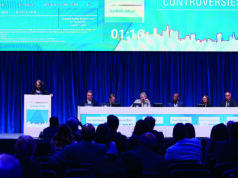
Erin Murphy (Atrium Health’s Sanger Heart and Vascular Institute, Charlotte, USA), one of the CX Symposium cochairs and a CX Executive Board member, along with fellow CX Executive Board members Stephen Black (Guy’s and St Thomas’ Hospital; King’s College London, London, UK) and Manj Gohel (Cambridge University Hospitals NHS Foundation Trust, Cambridge, UK; Imperial College London, London, UK), highlight what delegates can expect from the venous programme at CX 2024.
The mission of CX is to raise vascular and endovascular controversies to world-class faculty in order to challenge the available evidence and ultimately agree on steps forward after lengthy discussion.
“This year, we’re really looking forward to another spin of the controversies cycle,” Black tells Vascular News. “There is absolutely no shortage of controversies in the field of venous disease and treatment to help underpin a cutting-edge venous programme.”
“We have a broad venous programme designed to really cover all of the different challenging areas that an international venous audience will encounter, whether you work in the USA, the UK, Europe, the Middle East, or beyond,” Gohel adds.
Murphy says,“Charing Cross isn’t just another conference. It’s a dynamic force that’s been shaping the global vascular community across specialties for years. The venous programme is a cornerstone of the gathering.”
What to expect
Black is counting down to Steven Abramowitz’s (MedStar Health, Washington, DC, USA) presentation scheduled for day two (Wednesday, April 24).
The focus of the presentation will be on appropriate follow-up in clinical trials. Black emphasised the significance of this topic, stating that addressing appropriate follow-up is crucial for the successful execution of studies, particularly in the context of venous disease trials.
“We’re excited to continue our tradition of discussing the appropriateness of venous interventions with a great debate,” Black states. “Steve Elias [Englewood Hospital, Englewood, USA] will debate Gerry O’Sullivan [University Hospital Galway, Galway, Ireland] on the need for stenting in NIVL [non-thrombotic iliac vein lesion] patients, particularly in patients with a lower level of venous disease.”
“Elias will argue that the evidence supports treating CEAP 3 patients with varicose veins and swelling, all the way up to CEAP 6 patients with ulceration, while O’Sullivan will argue that the evidence is not supportive of this approach,” Black says.
“In many debates, participants may find themselves advocating for a position they don’t necessarily agree with. However, in this particular debate, there is a clear division in the data and evidence. Therefore, it promises to be a compelling discussion based on the existing disparities in evidence.”
As for why this debate is happening in the first place, Black states: “We do see complications from venous stenting. Stent migrations in particular, have been reported more frequently in America, where NIVL patients are treated more frequently. So, if we’re going to do procedures that carry risks for patients, we need to ensure that the necessity of the treatment is unequivocally established beforehand.”
EMBOLIZE trial
“I want you to keep an ear out for Gloria Salazar [University of North Carolina, Chapel Hill, USA],” Murphy tells Vascular News. “She’ll be introducing the groundbreaking EMBOLIZE trial. This is the first randomised controlled trial looking at the success of embolisation for pelvic congestion.
Murphy continues, explaining why this trial is so important. “We are currently facing challenges in obtaining insurance coverage for these patients,” she informs this newspaper. “Insurance denials often cite a lack of objective data and label the procedures as experimental.”
Murphy anticipates that this trial will help shift the situation and influence coverage plans to permit broader and enhanced treatment options for these patients. “At present, many women undergo procedures, such as hysterectomies, to address issues that could potentially be resolved with endovascular embolisation,” Murphy explains. “The associated risks with hysterectomy are certainly higher.”
VenaSeal Spectrum programme
The results from the VenaSeal Spectrum programme are some of the most highly anticipated data to be revealed this year. Sponsored by Medtronic, the VenaSeal Spectrum programme’s goal is to assess cyanoacrylate glue across three studies, one comparing it with endothermal ablation, one comparing it with surgical stripping, and one testing the device on venous leg ulcers.
“It’s been an incredible achievement for the investigators around the world to complete this series of three studies,” Gohel says. “The real goal of the Spectrum programme is to identify the positives, the effectiveness, the safety, and also the overall role of cyanoacrylate glue in what is quite a complex current landscape of superficial venous interventions.”
SYNCHRONOUS study
Another study that will be releasing data is SYNCHRONOUS which determined the impact of a synchronous prophylactic treatment of the anterior accessory saphenous vein on the recurrent varicose vein rate in patients undergoing thermal ablation of an insufficient great saphenous vein.
“An unbreakable rule in superficial venous treatment is not to treat a vein that is not refluxing,” Gohel says. “There are specific reasons why prophylactic treatment of the anterior accessory saphenous vein has been considered a good idea. The concern would be encouraging treatment, and potentially overtreatment of nonrefluxing veins.”
Podium firsts
Stephen Black will be giving a podium-first presentation at CX 2024 on the need for a dedicated inferior vena cava (IVC) stent.
“There are several venous stents available, but none of them are onlabel for use in the inferior vena cava,” Black notes. “Gore has developed a stent, Viafort, specifically designed for use in the IVC, making it the first of its kind.”
The Viafort IVC study is evaluating the performance, safety and efficacy of using the investigational Viafort stent for the treatment of symptomatic IVC obstruction with or without combined iliofemoral venous obstruction. It is a prospective, multicentre, nonrandomised, single-arm study.
Ahead of his presentation, Black explains why the Viafort stent is interesting to watch. Importantly, this pertains to the combination of stent size and its ability to withstand the movements of the diaphragm. Viafort utilises the Gore expanded polytetrafluoroethylene (ePTFE) technology in conjunction with a single-wire, sinusoidal-wound nitinol frame.
“The reason why we’re presenting this as a podium first is that the FDA [US Food and Drug Administration] allowed breakthrough device designation for this study, where we identify, and the FDA agrees, there is a significant clinical need and a significant need for innovation.”
CX 2024 workshop
Gohel also speaks about the venous workshop at this year’s CX.
“The workshop at Charing Cross is something that’s been going on for many years, and it’s an excellent opportunity for delegates to come and meet expert faculty, [participate in] interactive case discussions, and also to try the latest technology and equipment supported by our industry partners,” Gohel explains.
The workshops will take place in the middle of the industry space, which is an easily accessible area. “I certainly encourage people to visit the area for lots of interesting discussions and technological advances,” Gohel said.
Murphy also spoke about the workshop, urging symposium participants to explore it.
“We’re committed to offering a comprehensive venous workshop on the Tuesday of the programme,” Murphy states.
The workshop is “designed to take you through procedural steps, providing hands-on access to the most cutting-edge technologies available. It’s an unparalleled opportunity to elevate your clinical skills and stay ahead of the curve.”












